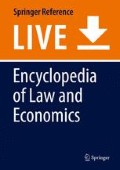Abstract
Credit rating agencies (CRAs) are pivotal players in financial markets, and in fact their conduct has attracted the attention of scholars, media, and policy analysts. A very common claim is that CRA behavior contributed to the explosion and the propagation of the recent financial crisis. This entry sketches the functioning of the market for ratings and explores the market failures by which it is characterized. Moreover, this entry briefly presents some of the proposals advanced by the law and economics literature to induce CRAs to issue accurate ratings.
References
Becker B, Milbourn T (2011) How did increased competition affect credit ratings? J Financ Econ 101:493
Bolton P, Freixas X, Shapiro J (2012) The credit ratings game. J Finance 67:85
Calomiris CW (2009) A recipe for ratings reform. Econ Voice 6:1
Choi S (1998) Market lessons for gatekeepers. Northwest Univ Law Rev 92:916–919
Coffee JC Jr (2004) Gatekeeper failure and reform: the challenge of fashioning relevant reforms. Boston Univ Law Rev 84:301
Coffee JC Jr (2006) Gatekeepers: the professions and corporate governance. Oxford University Press, Oxford
Coffee JC Jr (2011) Ratings reforms: the good, the bad and the ugly. Harv Bus Law Rev 1:231
Coval J et al (2009) The economics of structured finance. J Econ Perspect 23:3
Darcy D (2009) Credit rating agencies and the credit crisis: how the issuer pays conflict contributed and what regulators might do about it. C Bus Law Rev 2:605
Deats C (2010) Note, talk that isn’t cheap: does the first amendment protect credit rating agencies’ faulty methodologies from regulation? Columbia Law Rev 110:1818
Dennis K (2009) The rating game: explaining rating agency failures in the buildup to the financial crisis. Univ Miami Law Rev 63:1111
Dimitrov V et al (2015) Impact of the Dodd-Frank act on credit ratings. J Fin Econ 115:505
Flannery MJ et al (2010) Credit default swap spreads as viable substitutes for credit ratings. Univ Pennsylvania Law Rev 158:2085
Frost CA (2007) Credit rating agencies in capital markets: a review of research evidence on selected criticisms of the agencies. J Account Audit Finance 22:469
Goel AM, Thakor AV (2011) Credit ratings and litigation risk. Available at http://ssrn.com/abstract51787206
Gorton G, Ordoñez G (2014) Collateral crises. Am Econ Rev 104:343
Hill CA (2010) Justification norms under uncertainty: a preliminary inquiry. Conn Insur Law J 17:27
Hill CA (2003) Rating agencies behaving badly: the case of Enron. Conn Law Rev 35:1145
Krugman P (2010) Berating the raters, N.Y Times. http://www.nytimes.com/2010/04/26/opinion/26krugman.html?_r=0
Listokin Y, Taibleson B (2010) If you Misrate, then you lose: improving credit rating accuracy through incentive compensation. Yale J Regul 27:91
Macey (1998) Wall street versus main street: how ignorance, hyperbole, and fear lead to regulation. Univ Chicago Law Rev 65:1487
Mathis J, McAndrews J, Rochet J-C (2009) Rating the raters: are reputation concerns powerful enough to discipline rating agencies? J Monet Econ 56:657
Opp C et al (2013) Rating agencies in the face of regulation. J Financ Econ 108:46
Pacces A, Romano A (2015) A strict liability regime for rating agencies. Am Bus Law J 52:673
Partnoy F (1999) The Siskel and Ebert of financial markets?: two thumbs down for the credit rating agencies. Wash Univ Law Q 77:619
Partnoy F (2006) How and why credit rating agencies are not like other gatekeepers. In: Fuchita Y, Litan RE (eds) Financial gatekeepers: can they protect investors? Nomura Institute of Capital Markets Research/Brooking Institution Press, Tokyo/Washington, DC, p 61
Priest GL (1987) The current insurance crisis and modern tort law. Yale Law J 96:1521
Skreta V, Veldkamp L (2009) Ratings shopping and asset complexity: a theory of ratings inflation. J Monet Econ 56:678
White LJ (2010) Markets: the credit rating agencies. J Econ Perspect 24:211
Author information
Authors and Affiliations
Corresponding author
Editor information
Editors and Affiliations
Rights and permissions
Copyright information
© 2017 Springer Science+Business Media LLC
About this entry
Cite this entry
Romano, A. (2017). Credit (Rating Agencies). In: Marciano, A., Ramello, G. (eds) Encyclopedia of Law and Economics. Springer, New York, NY. https://doi.org/10.1007/978-1-4614-7883-6_667-1
Download citation
DOI: https://doi.org/10.1007/978-1-4614-7883-6_667-1
Received:
Accepted:
Published:
Publisher Name: Springer, New York, NY
Print ISBN: 978-1-4614-7883-6
Online ISBN: 978-1-4614-7883-6
eBook Packages: Springer Reference Economics and FinanceReference Module Humanities and Social SciencesReference Module Business, Economics and Social Sciences
Publish with us
Chapter history
-
Latest
Credit: Rating Agencies- Published:
- 26 November 2021
DOI: https://doi.org/10.1007/978-1-4614-7883-6_667-2
-
Original
Credit (Rating Agencies)- Published:
- 22 February 2017
DOI: https://doi.org/10.1007/978-1-4614-7883-6_667-1

